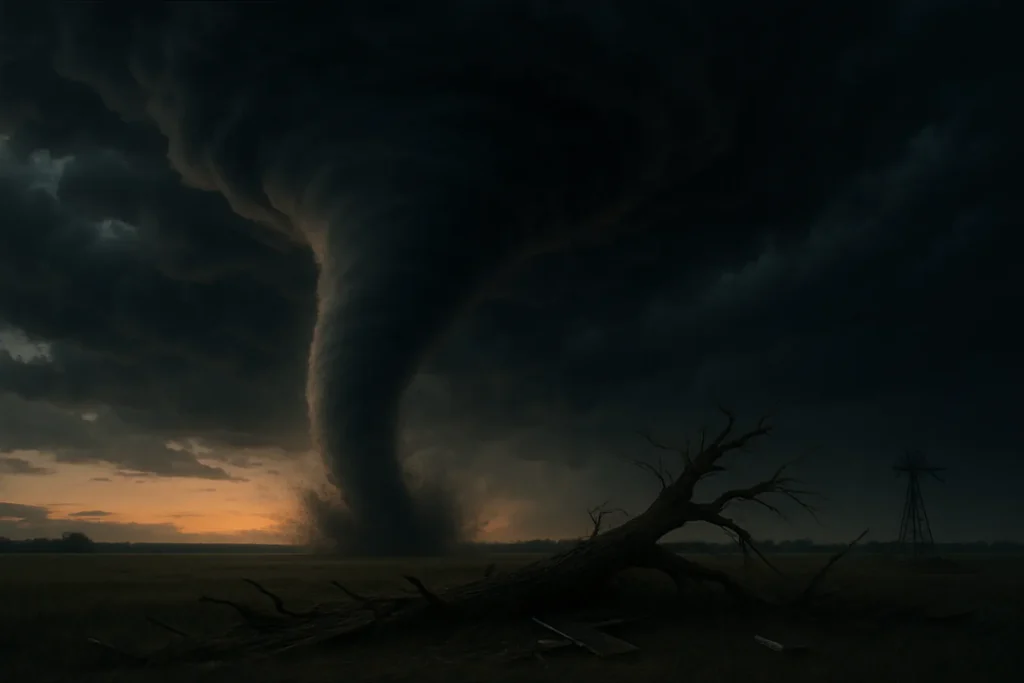Severe Weather Claims Lives and Causes Extensive Damage
Severe storms including tornadoes and powerful thunderstorms devastated parts of North Dakota and Minnesota, resulting in the confirmed deaths of three individuals near Enderlin, North Dakota, on Friday night. Emergency crews responding to calls found widespread damage in the region, including severely affected residential areas and transportation infrastructure. The National Weather Service (NWS) had earlier issued enhanced risk warnings anticipating strong tornadoes, large hail, and dangerously high winds.
Three people, two men and one woman, were found dead in Enderlin after reports of tornado damage. Storm chasers initially located two of the victims before official responders could arrive on the scene, underscoring the chaotic nature of the situation. Cass County Sheriff’s deputies later confirmed the identity of a third person who had been caught in the severe weather event.
Enderlin wasn’t the only location experiencing chaos; Bemidji Regional Airport in Minnesota faced substantial destruction after severe wind gusts of up to 106 mph tore through the airport, downing trees and trapping individuals in vehicles. The damage also impacted power infrastructure extensively, leaving nearly 34,000 Minnesotans and about 24,000 residents in North Dakota without electricity.
“Our crews have been working nonstop to safely restore power and assist those affected by this devastating storm,” said an emergency official overseeing recovery efforts in Minnesota.
The extensive damage prompted authorities to warn locals against unnecessary travel, citing blocked roads, fallen power lines, and gas leaks posing significant safety risks.
Chronology of a Devastating Night
Forecasters had issued specific warnings ahead of the storms, emphasizing a significant risk of severe weather for Friday afternoon into overnight, specifically from central eastern North Dakota to northern Minnesota. This forecast proved accurate, with severe weather ramping up considerably in the evening hours.
Early reports highlighted a rapidly escalating situation, with the NWS categorizing the storm threat at Level 3—an Enhanced Risk alert—across many areas, including Bismarck, Jamestown, and Fargo. The forecast explicitly mentioned a 10% probability of tornadoes, which resulted in heightened emergency response preparations.
Eyewitness accounts from North Dakota described terrifying scenarios of supercell thunderstorm activity, including hail larger than tennis balls and wind gusts nearing hurricane force. Several communities experienced flash floods as storms were slow-moving, compounding the difficulties for emergency responders and increasing the risk for stranded motorists.
“The roar of the wind and sound of hail striking our homes was deafening,” recounted a resident from the affected region. “Everyone was taking cover, uncertain of what morning would reveal.”
As the storm moved towards Minnesota overnight, Bemidji Regional Airport saw some of the strongest winds recorded at 106 mph. Damages included extensive tree falls, damage to parked vehicles, and structural impacts on airport facilities. Crews and volunteers have begun cleanup and repair operations, but it remains unclear how long full restoration efforts will take.
Historical Context and Broader Implications
The occurrence of deadly tornadoes and severe storms isn’t new to North Dakota and Minnesota, regions that frequently cope with severe weather, particularly during the spring and summer months. Historically, the Upper Midwest has witnessed numerous catastrophic tornado events. Notably, the 1957 Fargo tornado, one of the deadliest in state history, killed 10 and left substantial swaths of the city in ruins. Such historical precedents underline the importance of preparedness and timely weather alerts.
In recent years, improvements in forecasting have significantly enhanced the ability of authorities to issue precise warnings. However, storms such as the one on Friday night highlight challenges still faced in conveying the severe threat level to residents effectively. Emergency management officials reassessed their communications strategies following these incidents, emphasizing further enhancement of alert systems and public education.
The recent severe storms earlier in the week had already caused notable infrastructure damage across North Dakota, including the destruction of grain silos, farm buildings, and disrupted agriculture due to lost storage facilities. More concerning, a hazardous waste spill occurred at a Denbury Onshore injection well site, involving approximately 10,000 gallons of produced water and 13 gallons of crude oil. Environmental crews are working to mitigate ecological impacts while local businesses face significant financial strain from infrastructure damages.
“Every severe weather event is a stark reminder of the vulnerability of rural infrastructure and the critical necessity of robust emergency planning,” remarked a policy expert in disaster preparedness.
As cleanup efforts continue and authorities assess the full scope of damage, communities in these Midwestern states brace for the potential of additional severe weather. Officials urge continuous vigilance and adherence to government-issued safety guidelines, emphasizing ongoing risks that severe storms pose to life and property in the region.


